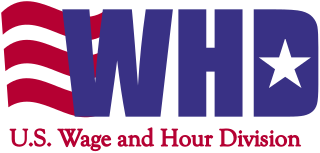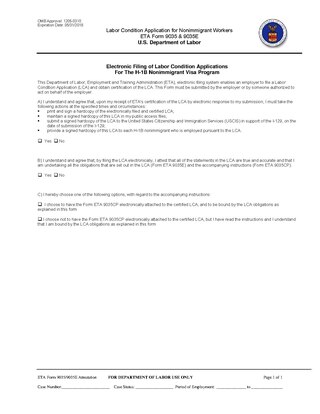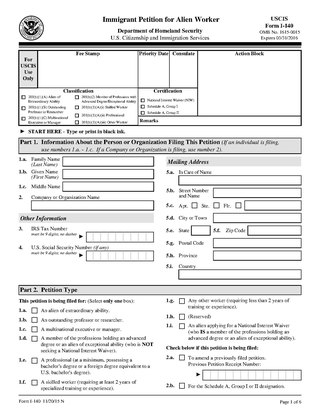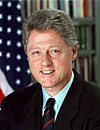Related Research Articles
The H-1B is a visa in the United States under the Immigration and Nationality Act, section 101(a)(15)(H) that allows U.S. employers to employ foreign workers in specialty occupations. A specialty occupation requires the application of specialized knowledge and a bachelor's degree or the equivalent of work experience. The duration of stay is three years, extendable to six years, after which the visa holder may need to reapply. Laws limit the number of H-1B visas that are issued each year. There exist congressionally mandated caps limiting the number of H-1B visas that can be issued each fiscal year, which is 65,000 visas, and an additional 20,000 set aside for those graduating with master’s degrees or higher from a U.S. college or university. Individuals cannot apply for H-1B visas on their own to allow them to work in the U.S. An employer must sponsor them for the visa. There were 206,002 new and initial H-1B visas were issued in 2022.
An L-1 visa is a visa document used to enter the United States for the purpose of work in L-1 status. It is a non-immigrant visa, and is valid for a relatively short amount of time, from three months to five years, based on a reciprocity schedule. With extensions, the maximum stay is seven years.
TN status is a special non-immigrant classification of foreign nationals in the United States, which offers expedited work authorization to a citizen of Canada or a national of Mexico. It was created as a result of provisions of the North American Free Trade Agreement that mandated simplified entry and employment permission for certain professionals from each of the three NAFTA member states in the other member states. The provisions of NAFTA relevant to TN status were then carried over almost verbatim to the United States–Mexico–Canada Agreement that replaced NAFTA in 2020.
An H-2A visa allows a foreign national worker into the United States for temporary agricultural work. There are several requirements of the employer in regard to this visa. The H-2A temporary agricultural program establishes a means for agricultural employers who anticipate a shortage of domestic workers to bring non-immigrant foreign workers to the U.S. to perform agricultural labor or services of a temporary or seasonal nature. In 2015 there were approximately 140,000 total temporary agricultural workers under this visa program. Terms of work can be as short as a month or two or as long as 10 months in most cases, although there are some special procedures that allow workers to stay longer than 10 months. All of these workers are covered by U.S. wage laws, workers' compensation and other standards; additionally, temporary workers and their employers are subject to the employer and/or individual mandates under the Affordable Care Act. Because of concern that guest workers might be unfairly exploited the U.S. Department of Labor Wage and Hour Division is especially vigilant in auditing and inspecting H-2A employers. H-2A employers are the only group of employers who are required to pay inbound and outbound transportation, free housing, and provide meals for their workers. H-2A agricultural employers are among the most heavily regulated and monitored employers in the United States. Unlike other guest worker programs, there is no cap on the number of H-2A visas allocated each year.
The Security Through Regularized Immigration and a Vibrant Economy Act of 2007 or STRIVE Act of 2007 is proposed United States legislation designed to address the problem of illegal immigration, introduced into the United States House of Representatives. Its supporters claim it would toughen border security, increase enforcement of and criminal penalties for illegal immigration, and establish an employment verification system to identify illegal aliens working in the United States. It would also establish new programs for both illegal aliens and new immigrant workers to achieve legal citizenship. Critics allege that the bill would turn law enforcement agencies into social welfare agencies as it would not allow CBP to detain illegal immigrants that are eligible for Z-visas and would grant amnesty to millions of illegal aliens with very few restrictions.

The Wage and Hour Division (WHD) of the United States Department of Labor is the federal office responsible for enforcing federal labor laws. The Division was formed with the enactment of the Fair Labor Standards Act of 1938. The Wage and Hour mission is to promote and achieve compliance with labor standards to protect and enhance the welfare of the Nation's workforce. WHD protects over 144 million workers in more than 9.8 million establishments throughout the United States and its territories. The Wage and Hour Division enforces over 13 laws, most notably the Fair Labor Standards Act and the Family Medical Leave Act. In FY18, WHD recovered $304,000,000 in back wages for over 240,000 workers and followed up FY19, with a record-breaking $322,000,000 for over 300,000 workers.
EB-2 is an immigrant visa preference category for United States employment-based permanent residency, created by the Immigration Act of 1990. The category includes "members of the professions holding advanced degrees or their equivalent", and "individuals who because of their exceptional ability in the sciences, arts, or business will substantially benefit prospectively the national economy, cultural or educational interests, or welfare of the United States, and whose services in the sciences, arts, professions, or business are sought by an employer in the United States". Applicants must generally have an approved labor certification, a job offer, and their employer must have filed an Immigrant Petition for Alien Worker with the USCIS.
The H-2B visa nonimmigrant program permits employers to hire foreign workers to come temporarily to the United States and perform temporary nonagricultural services or labor on a one-time, seasonal, peakload or intermittent basis.

The Border Security, Economic Opportunity, and Immigration Modernization Act of 2013 was a proposed immigration reform bill introduced by Sen. Charles Schumer (D-NY) in the United States Senate. The bill was co-sponsored by the other seven members of the "Gang of Eight", a bipartisan group of U.S. Senators who wrote and negotiated the bill. It was introduced in the Senate on April 16, 2013 during the 113th United States Congress.

The Labor Condition Application (LCA) is an application filed by prospective employers on behalf of workers applying for work authorization for the non-immigrant statuses H-1B, H-1B1 and E-3. The application is submitted to and needs to be approved by the United States Department of Labor Employment and Training Administration (DOLETA)'s Office of Foreign Labor Certification (OFLC). The form used to submit the application is ETA Form 9035.
The American Competitiveness in the 21st Century Act (AC21) was an act passed by the government of the United States in October 2000, pertaining to immigration to the United States. It was a complement to the American Competitiveness and Workforce Improvement Act that had been passed in 1998. The focus of AC21 was to change rules related to portability and caps for the H-1B visa to increase the effective number of visas available and make it easier for workers on those visas to switch jobs. Although the language of the Act references the Immigration and Naturalization Service (INS), the INS would soon be restructured and the functions of the INS referenced in AC21 would be handled by United States Citizenship and Immigration Services.
The H-1B Visa Reform Act of 2004 was a part of Title IV of the Consolidated Appropriations Act, 2005 in the United States that focused on changes to regulations governing H-1B visas. It was a successor to previous legislative changes affecting the H-1B, namely: the Immigration Act of 1990, American Competitiveness and Workforce Improvement Act (ACWIA) of 1998, and the American Competitiveness in the 21st Century Act (AC21) of 2000. The Consolidated Appropriations Act was signed by George W. Bush, then President of the United States, in early December 2004.
The Employ American Workers Act (EAWA) was a component of the American Recovery and Reinvestment Act of 2009 passed by the 111th United States Congress and signed into law by Barack Obama, then President of the United States, on February 17, 2009. The Act had a validity period of two years and was set to expire on February 17, 2011. It was not renewed, hence it sunset on February 17, 2011 and is no longer applicable.
The Legal Immigration Family Equity Act of 2000, also known as the LIFE Act and as the Legal Immigration and Family Equity Act, along with its Amendments, made some changes to laws surrounding immigration for family members of United States citizens and Lawful Permanent Residents, as well as people eligible for employment-based immigrant visas, in the direction of making it easier for family members and immigrant workers to move to and adjust status within the United States. It was passed on December 21, 2000, as title XI of Pub. L. 106–553 (text)(PDF).

Form I-140, Immigrant Petition for Alien Worker is a form submitted to the United States Citizenship and Immigration Service (USCIS) by a prospective employer to petition an alien to work in the US on a permanent basis. This is done in the case when the worker is deemed extraordinary in some sense or when qualified workers do not exist in the US. The employer who files is called the petitioner, and the alien employee is called the beneficiary; these two can coincide in the case of a self-petitioner. The form is 6 pages long with a separate 10-page instructions document as of 2016. It is one of the USCIS immigration forms.
The term H-1B-dependent employer is used by the United States Department of Labor to describe an employer who meets a particular threshold in terms of the fraction of the workforce comprising workers in H-1B status. An employer classified as H-1B-dependent needs to include additional attestations in the Labor Condition Application used for the petition of any H-1B beneficiary being offered an annual compensation of less than $60,000 and without a master's degree. The notion was introduced by the American Competitiveness and Workforce Improvement Act (ACWIA) passed in 1998 and operationalized through the United States Department of Labor's Interim Final H-1B Rule of December 20, 2000. The regulation is found in 20 CFR 655.736 in the Code of Federal Regulations.
In the United States, the most common visa used for short-term trips is the B visa. This is a combination of the B-1 visa and the B-2 visa. People on B visas are generally not allowed to engage in productive work or study activities. However, in some cases, B visas can be issued that allow people to engage in some types of productive work and learning activity, in lieu of another visa. The three visa categories, for which a B visa could be issued instead, are the H-1B visa, H-3 visa, and J-1 visa. The U.S. Department of State recommends that consular officers clearly annotate such B visas to make the scope of the visa clear to the applicant and the U.S. Customs and Border Protection officer at the port of entry.
The H-1C visa was a visa that was previously available to foreign nationals seeking temporary employment in the United States. These visas were made available to foreign nurses coming into the United States to perform services as a registered nurse in areas with a shortage of health professionals as determined by the Department of Labor. The creation of this visa was prompted by a nursing shortage.
A public access file is a file that needs to be maintained by any United States employer hiring people in H-1B, H-1B1, or E-3 temporary nonimmigrant worker statuses. It is intended to include more background information related to the attestations made on the Labor Condition Application used for the Form I-129 and/or visa application that was used to acquire the nonimmigrant worker status. The file may be requested by any member of the public through telephone or email inquiries. Any member of the public requesting access to the documents must be allowed to capture the information through such means as transcription, scanning, or taking photographs, for example. It is distinguished from a private access file that contains more sensitive and confidential employee data that must be shared with the U.S. Department of Labor if they choose to investigate. Regulations governing the public access file can be found in the Code of Federal Regulations, Title 20, or more specifically, in 20 CFR 655.760.
The H-1A visa was a visa that was previously available to foreign nationals seeking temporary employment in the United States. These visas were made available to foreign nurses coming into the United States to perform services as a registered nurse in areas with a shortage of health professionals as determined by the Department of Labor. The creation of this visa was prompted by a nursing shortage.
References
- ↑ "American Competitiveness and Workforce Improvement Act of 1998". Office of Administrative Law Judges, United States Department of Labor. October 21, 1998. Archived from the original on December 25, 2014. Retrieved March 15, 2015.
- 1 2 Hahm, Jung (September 1, 2000). "American Competitiveness and Workforce Improvement Act: Balancing Economic and Labor Interest under the New H-1B Visa Program". Cornell Law Review . 85 (6). Retrieved March 15, 2015.
- 1 2 Bier, David (July 22, 2016). "Why Congress Rejected an H-1B Recruitment Requirement". Cato Institute . Retrieved February 5, 2017.
- ↑ "Congressional Record Vol. 144-Part 7: Proceedings and Debates of the 105th United States Congress" . Retrieved February 5, 2017.
- ↑ Lowell, Lindsay (May 2000). "H-1B Temporary Workers: Estimating the Population" . Retrieved March 15, 2015.
- ↑ Lin, Carl (2011-06-12). Give Me Your Wired and Your Highly Skilled: Measuring the Impact of Immigration Policy on Employers and Shareholders (Report).
- ↑ "Why More Immigration, Not Less, Is Key to U.S. Economic Growth". Bloomberg. October 28, 2012. Retrieved March 15, 2015.
- ↑ Ruiz, Neil; Wilson, Jill (March 13, 2013). "Better Align H-1B Visa Fee Revenues to Local Workforce Needs" (PDF). Brookings Institution . Retrieved March 15, 2015.

